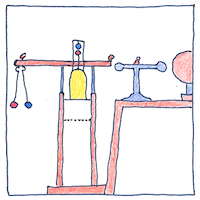Humphry Davy,
Henry Cavendish
electromagnetism

|
Electric conductivity
Humphry Davy experimented with powerful direct currents from an adjustable battery of voltaic cells at the Royal Society consisting of two thousand double plates of zinc and copper in various mixtures of water and nitrous and sulfuric acids. In a series of experiments to determine the relations of different conductors to the magnetism produced by electricity, Humphry Davy found that induced magnetism was not affected by the electrification of the magnetized metal, or by its agitation in the case of liquid mercury in a glass tube, or by whatever was used to conduct the electricity. Furthermore, Davy realized that there was a limit to the quantity of electricity that a wire could transmit. When exceeded, the wire would turn red hot or fuse and the flow of electricity would stop or severely diminish. Davy conducted experiments to determine how the limit varied by the temperature, mass, surface, length, and induced magnetism of the wire. Davy found that conductivity of metallic bodies “was lower in some inverse ratio as the temperature was higher,” whether the heat was caused by the electricity or by an external flame. Using water to cool wires of different metals, Davy found that silver was the best conductor, followed by copper, lead, gold, zinc, tin, platinum, palladium, and iron, that the longer the wire, the less it would conduct, that the more massive the wire, the more it would conduct, and that the shape of the wire didn’t matter. * Davy wrote, “But till the causes of heat and of electricity are known, and of that peculiar constitution of matter which excites the one, and transmits or propagates the other, our reasoning on this subject must be inconclusive.” However, Davy realized that “if heat be supposed a substance, it cannot be imagined to be expelled from the platinum; because an unlimited quantity may be generated from the same platinum, i.e. as long as the electricity is exited . . or renewed.”
The electrical researches of the Honourable Henry Cavendish
James Clerk Maxwell, Cavendish Professor of Physics at Cambridge, with access to the papers of Henry Cavendish, published in 1879 a complete edition and analysis of the private researches of Henry Cavendish. Between 1771 and 1781, Cavendish wrote of the capacity of a conductor, of the degree of electrification, and of the conductivity of various substances, “that iron wire conducts about 400 million times” and “sea water . . . conducts 100 times” “better than rain or distilled water.” Forty years before the invention of the galvanometer, which today we use to compare electrical resistance, Cavendish used his own body to compare the intensity of currents conducted through a variety of substances. He compared the conductivity of saltwater with various concentrations of salt at various temperatures and found for lower concentrations that heat improved conductivity but for higher concentrations heat made no difference. His studies preceded the work of Charles-Augustin Coulomb and were conducted with static electricity from Leyden jars.
Electric fluid
Henry Cavendish considered electricity to be a liquid or elastic form of matter whose particles repel each other and are attracted to particles of ordinary matter (which also repel each other). Electric fluid is interspersed among all particles of ordinary matter, and normally it exists in a degree of saturation that balances attractive and repulsive forces. When a body has too little electric fluid, it is undercharged, and when it has too much, it is overcharged, so that the electric fluid can move from overcharged to undercharged bodies. When a body can conduct electricity, Cavendish considered its electric fluid to be moveable. And when a body can not conduct electricity, Cavendish considered its electric fluid to be immoveable.



Cavendish’s “electric fluid” model was not far off considering that electrons would not be discovered until 1897.
Cavendish measured conductivity by how much of a shock it gave him. Davy measured resistance by how much a conducting wire would heat oil that it was submerged in, and he measured electromagnetism by how much iron filings the electromagnet would pick up.
Both Cavendish and Davy discovered that temperature effects conductivity.
See also in The book of science:
Readings in wikipedia:
Other readings: